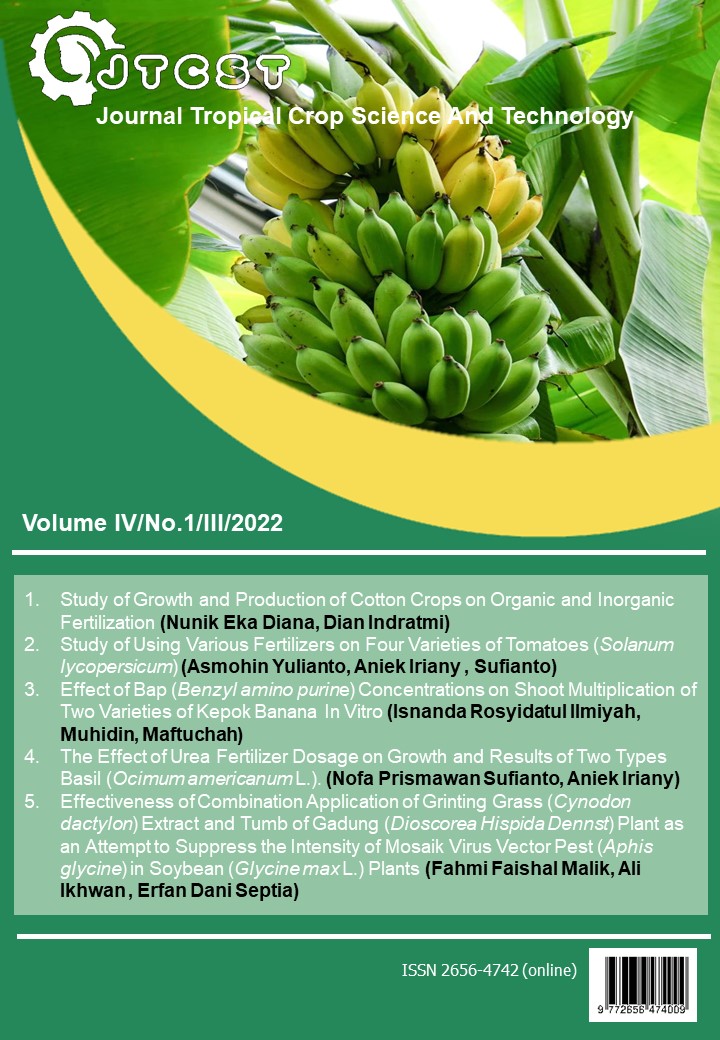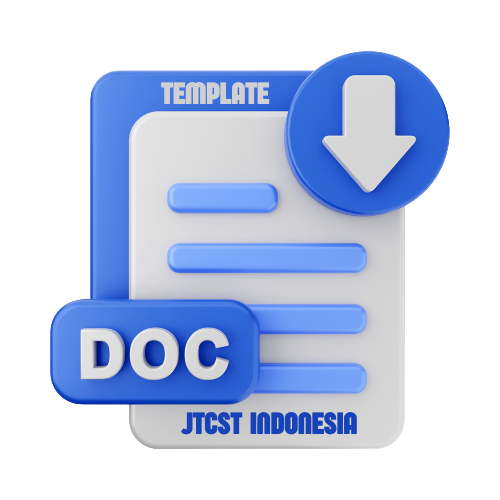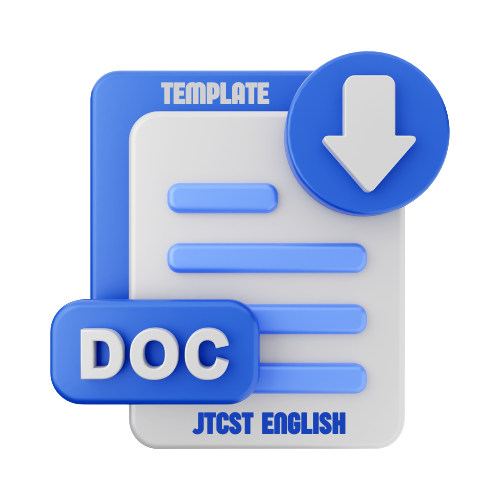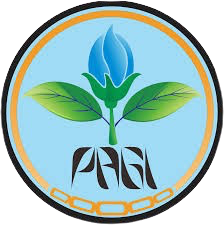Effectiveness of Combination Application of Grinting Grass (Cynodon Dactylon) Extract and Tumb of Gadung (Dioscorea Hispida Dennst) Plant as an Attempt to Suppress the Intensity of Mosaik Virus Vector Pest (Aphis Glycine) in Soybean (Glycine Max L.) Plants
DOI:
https://doi.org/10.22219/jtcst.v4i1.32480Keywords:
Indigenous Bacteria, Pyricularia sp, Synergy, Inhibition, RegressioAbstract
A. glycine soybean infestation caused yield loss reaching 58%.
Environmental friendly controls are carried out using natural
ingredients. This study was conducted to determine the
effectiveness of the combination of gadung and grass grinting tuber
extracts on soybean virus (A. glycine) vector pests and to know the
mechanism of toxicity to these pests. This research was conducted
from June to September 2018. The effectiveness of applications
using simple Randomized Completed Block Design (RCBD).
Analysis of Varian at 5% level, and Duncan's Multiple Range Test
(DMRT) test. Calculations of LC50 and LT50 use probit regression
analysis. The results showed that the highest compounds
contained in gadung tubers were alkaloids, whereas in grinting
grasses were saponins. Both of these compounds have the
potential as a base for vegetable insecticides. The combination
treatment of gadung extract and grinting 3: 2 (v / v) (P7) and 3: 1
(P8) showed the most effective results compared to positive
controls and other treatments with mortality mean values at all
observations of 87.44% and 86, 7%. The LC50 value of gadung
extract at the first observation was 3%, the grinting extract was
3.08%. The lowest LT50 value is in treatment P7 (3: 2) with a time
of 3.88 hours. a combination of gadung extract and grinting can
suppress A.glycine infestation and potentially a plant-based
insecticide.
Downloads
References
Andayanie, W. (2012). Diagnosis Penyakit Mosaik (Soybean Mosaic Virus) Terbawa Benih Kedalai. J. HPT Tropika, Vol. 12 No. 2: 185-191.
Chaeib, I. (2010). Saponin as Insecticides: a review . Tunisian Journal of Plant Protection, 5. 39-50.
Clark, A., & Perry , K. (2002). Transmissibility of field isolates viruses by Aphis glycine . Plant Disease 86, 1219-1222.
Harahap , & Rakhmadiah , K. (2016). Uji Beberapa Konsentrasi Tepung Daun Sirih Hutan (Piper aduncun L.) untuk Mengendalikan Hama Sitophilus zeamais M. Pada Biji Jagung di Penyimpanan . Jurnal Agroekotek 8, 2. 82-94.
Hill, J., Alleman, D., Hogg, D., & Grau, C. (2001). First report of transmission of Soybean mosaic virus and Alfalfa mosaic virus by Aphis glycine in the New World . Plant Disease 85, 561.
Kementan. (2016). Outlook Komoditas Pertanian Pangan. KEDELAI: Pusat Data dan Sistem Informasi Pertanian.
Koirewoa, Y., Fatmawali, & Wiyono, W. (2012). Isolasi dan Identifikasi Senyawa Flavonoid dalam Daun Beluntas (Pluchea indica L.) . Ejournal.unsrat.ac.id, Hal. 47-52.
Koswara, S. (2013). Teknologi Pengolahan Umbi-umbian. Bogor: Institut Pertanian Bogor.
Martowo, Hardiningsih, S., & Taufiq, A. (2014). Hama, Penyakit dan Masalah Hara pada Tanaman. Bogor: Puslitbangtan.
Marwoto. (2007). Dukungan Pengendalian Hama Terpadu dalam Program . Jurnal Iptek Tanaman, 2. 79-92.
McCornack, B., Costamagna, A., & Ragsdale, D. (2008). Within-plant distribution of soybean aphid (Hemiptera: Aphididae) and development of node-based sample units for estimating whole-plant densities in soybean. Journal of Economic Entomology, 101. 488-500.
Muchtadi, D. (2010). Kedelai: Komponen Bioaktif Untuk Kesehatan. Bandung: Alfabeta.
Panuganti, S. (2015). Principles Involved in Bioassay by different Methods: A Mini-Review. RRJOB, 3. 1-18.
Prayogo, D., Thamrin, H., & Nugroho. (2017). Pengaruh Pengendalian Gulma Pada Pertumbuhan Hasil Tanaman Kedelai (Glycine max L.) Merril Pada Berbagai Sistem Olah Tanah. Jurnal Produksi Tanaman, 5. 24-32.
Siamtuti, W., Aftiarani, R., Wardhani, Z., Alfianto, N., & Hartoko. (2017). Potensi Tannin pada Ramuan Nginang Sebagai Insektisida Nabati Ramah Lingkungan. Bioeksperimen, 3, 2.
Tilmon , K., Hodgson, E., & O'Neal, M. (2011). Biology of the Soybean Aphid, Aphis. Journal of Intergrated Pest Managment 2, 2. 1-7.
Downloads
Published
How to Cite
Issue
Section
License
Copyright (c) 2022 Fahmi Faishal Malik , Ali Ikhwan, Erfan Dani Septia

This work is licensed under a Creative Commons Attribution-ShareAlike 4.0 International License.
Authors who publish with this journal agree to the following terms:
- Authors retain copyright and grant the journal right of first publication with the work simultaneously licensed under a Creative Commons Attribution License that allows others to share the work with an acknowledgement of the work's authorship and initial publication in this journal.
- Authors are able to enter into separate, additional contractual arrangements for the non-exclusive distribution of the journal's published version of the work (e.g., post it to an institutional repository or publish it in a book), with an acknowledgement of its initial publication in this journal.
- Authors are permitted and encouraged to post their work online (e.g., in institutional repositories or on their website) prior to and during the submission process, as it can lead to productive exchanges, as well as earlier and greater citation of published work (See The Effect of Open Access).











